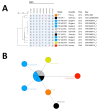Case Report of an Injectional Anthrax in France, 2012
- PMID: 32630109
- PMCID: PMC7409126
- DOI: 10.3390/microorganisms8070985
Case Report of an Injectional Anthrax in France, 2012
Abstract
(1) Background: Bacillus anthracis is a spore-forming, Gram-positive bacterium causing anthrax, a zoonosis affecting mainly livestock. When occasionally infecting humans, B. anthracis provokes three different clinical forms: cutaneous, digestive and inhalational anthrax. More recently, an injectional anthrax form has been described in intravenous drug users. (2) Case presentation: We report here the clinical and microbiological features, as well as the strain phylogenetic analysis, of the only injectional anthrax case observed in France so far. A 27-year-old patient presented a massive dermohypodermatitis with an extensive edema of the right arm, and the development of drug-resistant shocks. After three weeks in an intensive care unit, the patient recovered, but the microbiological identification of B. anthracis was achieved after a long delay. (3) Conclusions: Anthrax diagnostic may be difficult clinically and microbiologically. The phylogenetic analysis of the Bacillus anthracis strain PF1 confirmed its relatedness to the injectional anthrax European outbreak group-II.
Keywords: drug-user; injectional anthrax; outbreak; phylogeny.
Conflict of interest statement
The authors declare no conflict of interest.
Figures


References
-
- Keim P., Grunow R., Vipond R., Grass G., Hoffmaster A., Birdsell D.N., Klee S.R., Pullan S., Antwerpen M., Bayer B.N., et al. Whole Genome Analysis of Injectional Anthrax Identifies Two Disease Clusters Spanning More Than 13 Years. EBioMedicine. 2015;2:1613–1618. doi: 10.1016/j.ebiom.2015.10.004. - DOI - PMC - PubMed
-
- Ruckert C., Licht K., Kalinowski J., Espirito Santo C., Antwerpen M., Hanczaruk M., Reischl U., Holzmann T., Gessner A., Tiemann C., et al. Draft genome sequence of Bacillus anthracis UR-1, isolated from a German heroin user. J. Bacteriol. 2012;194:5997–5998. doi: 10.1128/JB.01410-12. - DOI - PMC - PubMed
Publication types
LinkOut - more resources
Full Text Sources
Molecular Biology Databases

